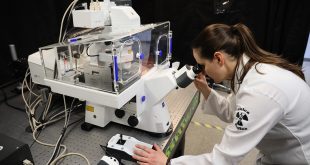Ongoing research into cannabis in the public sector, coupled with both the emergence of large cannabis corporations and a newfound interest in the power of cannabinoids within the pharmaceuticals sector, is increasingly translating into exciting research that aims to close the gap between the many anecdotal uses for medical cannabis and what the science shows. And plenty are interested in getting onboard with this, from dedicated pharmaceutical companies working with cannabinoid-based compounds to recreational cannabis companies hoping to produce heartier crops and grow plants with specialized adaptations.
Tetra Bio-Pharma
On the pharmaceutical end of the spectrum lies Ottawa’s Tetra Bio-Pharma, a TSX-listed pharmaceutical research outfit with a number of ongoing clinical trials. Their flagship trial, branded REBORN, is in Phase 2, studying the efficacy of using cannabinoids to treat breakthrough pain in patients with advanced cancer.
Because of its proximity to the pharmaceutical industry, it might be no surprise that Tetra straddles the world of cannabis and synthetics. In October, it announced plans to launch REDUVO in Canada – a synthetic form of THC known as dronabinol, or possibly better known by its US trade name, Marinol.
The key insight that CEO Guy Chamberland, who is also a master herbalist, believes he and his company have found is that cannabis in its natural form has always been inhaled, and that every attempt to circumvent this with a non-smokable form has ultimately struggled to be as effective. Consumed any other way — eaten, swallowed, injected — cannabis tends not to work quite the same way. But inhalation (or vaporization), as anyone who has smoked it knows, is capable of delivering the relief quickly — so quickly, in fact, that Chamberland believes that the Phase 2 trial of their flagship cancer pain drug QIXLEEF “can provide pain relief faster than an immediate-release oral morphine.”
“The research we’ve been doing is mainly developing what they call a dried flower cannabis product as a prescription drug,” Chamberland says. “One of the things I’ve learned over the years is do not step away from the traditional use of the plant when you’re using it to treat somebody.
“When you see that type of evidence, you start to understand why smoked cannabis has always been preferred by patients.”
The QIXLEEF Phase 2 clinical trial, which focuses on breakthrough pain in cancer patients, is considered the company’s priority study, and began in May 2021. It is hoping to show positive effects in the treatment of breakthrough cancer pain.
Spectrum Therapeutics & Canopy Growth
In late 2018, the cannabis producer Canopy Growth announced that Michael John Milloy would be named the inaugural Canopy Growth Professor in Cannabis Science at the University of British Columbia (UBC). It wasn’t the first partnership between academia and a private sector cannabis company, but it was among the most visible: a high-profile research position sponsored by one of the country’s largest cannabis companies, a statement that the cannabis industry wanted to have a seat at the research table.
Spectrum Therapeutics, the medical cannabis subsidiary of Canopy Growth, has focused much of its research attention, like Tetra Bio-Pharma, on developing cannabis as a replacement for opioids. Milloy came to the position as a research scientist within the British Columbia Centre on Substance Use (BCCSU) “The therapeutic benefits of cannabis are only just beginning to be understood,” said Milloy in late 2018. “Early research has shown that it could have a stabilizing impact for people with opioid use disorder, improving their quality of life and offering a pathway to long-term treatment solutions. In the midst of an overdose crisis, we have a scientific imperative to build upon this research.”
Unlike Tetra, Spectrum doesn’t yet find itself in the same clinical trial game, content to operate within the medical cannabis space. Their research has focused on more practical applications with direct links to the ongoing overdose crisis. A recent paper, published in November 2020, focused on titration methods to successfully transition people from opioid-based painkillers to cannabis. A slightly earlier study also found that daily cannabis users were 24 per cent more likely to kick an intravenous drug dependency, and that using cannabis at this rate also made one less likely to start injecting to begin with. “Cannabis can help us save lives, particularly among the people shouldering the burden of the overdose crisis,” Milloy told The Tyee in 2020.
Aurora Cannabis
Aurora Cannabis, one of Canada’s first and largest cannabis producers, has identified the development of new genetics as being key to its growth and its pivot towards being a more medically-focused cannabis company amidst continued losses in the recreational market. In May 2021, the company launched a dedicated Science & Innovation group with hopes of commercializing “key aspects of cannabinoid biosynthesis in plants and microorganisms.”
“This is a long-term effort, but one that we believe will ultimately allow companies to bring a wide array of new-generation products to the market,” said their new CEO, Miguel Martin, on a September 2021 earnings call. In August and September 2021, the first three cultivars created at Aurora Coast, the company’s research and development facility in Comox, B.C., were released. “We’re already seeing the results, through nearly $1 million in sales since their launch,” said Martin. “The genetics and breeding program, which is an asset-light business model, is always expected to generate high-margin revenue.”
To that end, one of the projects they are supporting is the aforementioned research of Loren Rieseberg at UBC. The intended by-product of Riseberg’s work — undertaken with Marco Todesco at UBC, with Greg Baute and Charles Pick of Aurora Cannabis and Pascal Spothelfer of Genome BC — on cannabis genetics is to breed a strain of cannabis that can resist the powdery mildew, a dangerous nuisance for cannabis growers. According to the company, the improved cannabis cultivars will “result in reduced losses to pathogen contamination and increase product quality.”
 BioLab Business Magazine Together, we reach farther into the Canadian Science community
BioLab Business Magazine Together, we reach farther into the Canadian Science community





